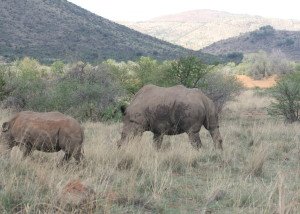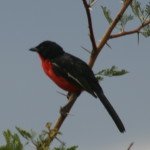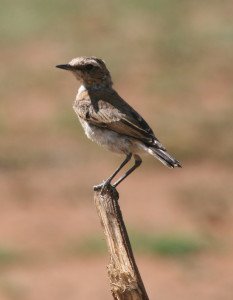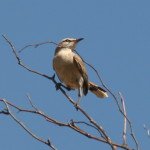Pilanesberg National Park 0

SERENE … A White Rhinoceros and its calf with the valleys of the Pilanesberg stretching into the distance
The open country around the Mankwe Dam is bordered by the Tshwene and Kubu drives, two of the four tar roads in the Pilanesberg National Park. I normally try to avoid the tar roads when I’m in the bush, but this area is so peaceful and tranquil, and being the main water source in the reserve, there is also usually lots of game in the vicinity.
But as a very warm afternoon clouded over and a typical Highveld thunderstorm approached, there came a stark reminder that this is wild Africa, red in tooth and claw.
Between the Mankwe and Motlobo drive turnoffs from Tshwene Drive, less than 20 metres from the tar and at the edge of a little bank, an unfortunate Impala took its last breaths. Two Cheetah, still panting hard from the exertions of the chase, soon had blood-stained faces as they tucked into their hard-won meal.
This is Lion and Leopard country as well so the Cheetah, the most lightweight of the big cats, needs to eat quick because there’s nothing like a kill to attract other meat-eaters. While the Cheetahs ripped at the carcass, a sly Blackbacked Jackal was already hanging around waiting for scraps.
Seeing one of the cats on a kill is always a special sighting, but to see Cheetah in the Pilanesberg is an exceptional occurrence because there are only five in the entire 572 square-kilometre park. The open country around Mankwe Dam is probably the best area for them because it allows them the space for their sprint, which is what sets them apart from other predators.
The adrenaline was still flowing from my first Cheetah sighting in the Pilanesberg when my buzz was shattered by an extremely loud, piercing call right next to the car. I was startled and momentarily baffled by what it could be – it was such a high-pitched, pure sound that I thought some sort of emergency alarm had gone off and was wondering if my windshield would crack!
Having regained my senses enough to realise that it was coming from the bushes next to the road, I scanned the vegetation and there the source was, with colours as bright as its song was loud – a beautiful Crimsonbreasted Shrike sitting in an open gap in the bushes.
The Crimsonbreasted is certainly the most brightly coloured of the Laniarius (Boubou) Shrikes and its underparts are a brilliant scarlet colour, heading towards crimson.
It provides a real flash of colour particularly when contrasted with the muted tones of the thorny scrub it likes to inhabit.
This is where the Mankwe River flows out of the dam and Mankwe Way crosses the river just north of the Fish Eagle turnoff. It’s a good spot to stop and scan for birds and, having seen one in the exact same dead tree on a previous trip, it was great to see an Osprey once again sitting up in the highest branches. It was joined by a Hamerkop that came to share its lofty perch and there were Pearlbreasted Swallows flying around and landing nearby as well.
Mankwe Way takes one into an area of open grassland, dotted with termite mounds and boulders as it heads west, past the old farm of General Jan Smuts, Buffelsdrift. Transitional zones where dry plains with short grass meet the longer grasses of the rugged upland areas are excellent for birding as well.
Apart from the White Rhinoceros in the vicinity, there were also Scalyfeathered Finches hopping on the ground and then flying quickly into the small trees when disturbed; Sabota Lark, Crowned Plover, Cinnamonbreasted Rock Bunting and Blackthroated Canary.
But a pair of birds had me a bit confused as they hopped around on the low bushes, behaving much like Capped Wheatears. But the adults of that plains specialist are distinctively marked and these birds were also making some strange, Lark-like calls. With their mottled bands of brown, buff and yellowish colours, they had me thinking of similar-looking rarities.
But discretion won the day and, considering that Capped Wheatears are well-known mimics, I went the most likely route and decided they were, in fact, a pair of immature Capped Wheatears.
Pilanesberg holds good numbers of both the Kalahari and Whitebrowed Scrub Robins and the central part of the
park has both these twitching, insectivorous lovers of thicket and low bushes in close proximity to each other.
Mankwe Dam is by no means the only productive body of water in the park, and if one enters through the south-western gate of Bakubung, after two-and-a-half kilometres on the tarred Kubu Drive, or a bit further if one turns left and takes the more meandering dirt road known as Kgama Drive, one comes to the Lengau Dam.
There are usually large numbers of birds here and on this occasion it was good to see African Darter, Whitefaced Duck, Pied Kingfisher, Greenshank, Marsh Sandpiper and Threebanded Plover. There are usually animals about as well, but this time there was just a solitary Warthog snuffling around.
Even the smallest bodies of water can provide something of interest though and as I was exiting through the easternmost gate – Manyane – four Redbilled Oxpeckers were drinking water from a puddle in the road.
Life can be very tough in the beautiful African bush and to survive the residents need to take advantage of every little windfall they can get.
Sightings List
Blue Wildebeest
Plains Zebra
Sacred Ibis
Warthog
Egyptian Goose
African Darter
Whitefaced Duck
Laughing Dove
Little Swift
Pied Kingfisher
Greenshank
Blacksmith Plover
Marsh Sandpiper
Threebanded Plover
Waterbuck
Jackal Buzzard
Impala
Greater Kudu
Rufousnaped Lark
Palm Swift
Marico Flycatcher
Greater Striped Swallow
Giraffe
Crested Francolin
Streakyheaded Canary
Great White Egret
Southern Masked Weaver
Pintailed Whydah
Blackeyed Bulbul
Whitebrowed Scrub Robin
Blackchested Prinia
Kalahari Scrub Robin
White Rhinoceros
Scalyfeathered Finch
Sabota Lark
Capped Wheatear
Crowned Plover
Cinnamonbreasted Rock Bunting
Blackthroated Canary
Hamerkop
Osprey
Pearlbreasted Swallow
Natal Francolin
Cape Turtle Dove
Grey Lourie
Glossy Starling
Cheetah
Blackbacked Jackal
Helmeted Guineafowl
Rattling Cisticola
Crimsonbreasted Shrike
African Elephant
Forktailed Drongo
Common Myna
Redbilled Oxpecker



